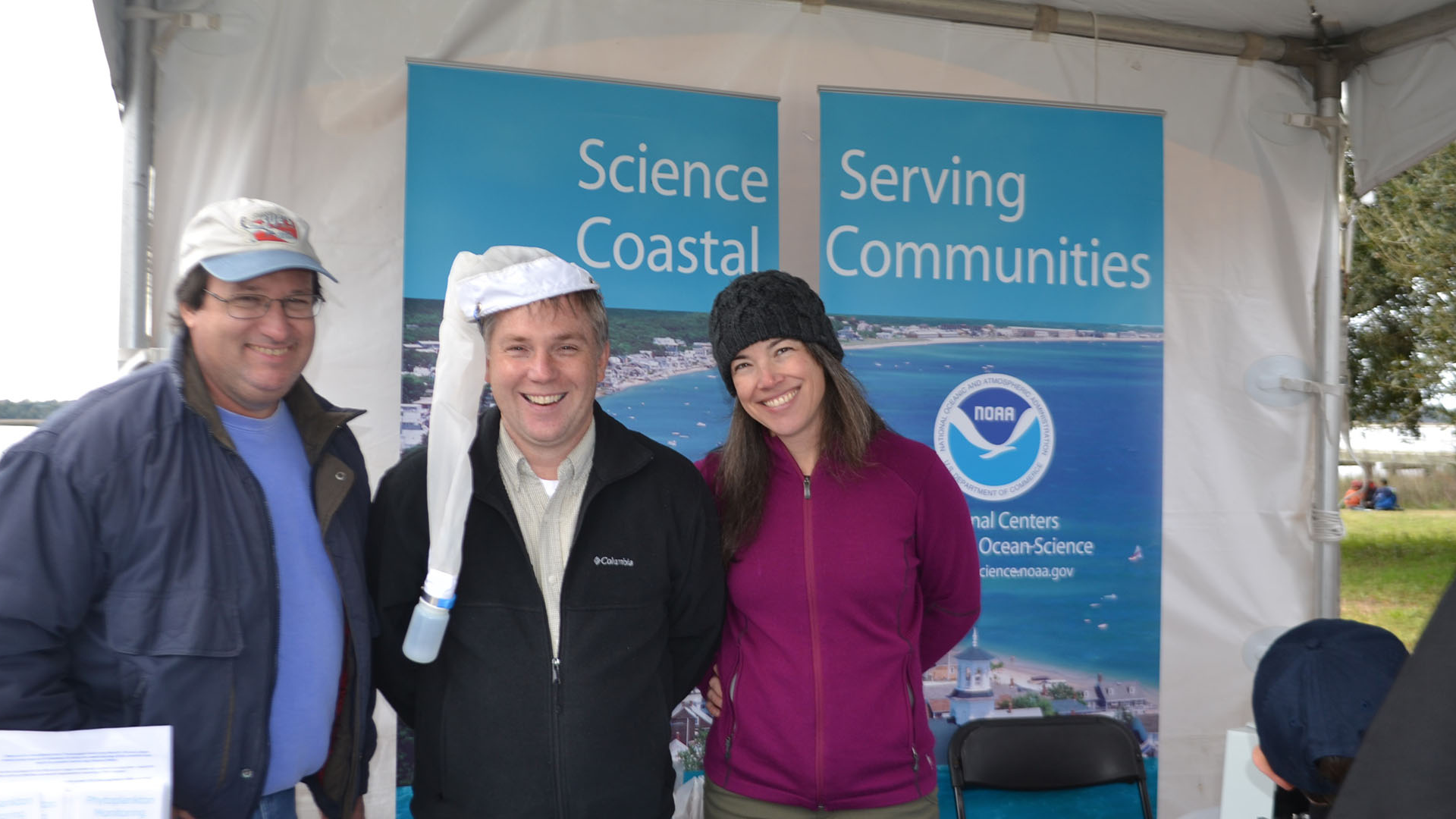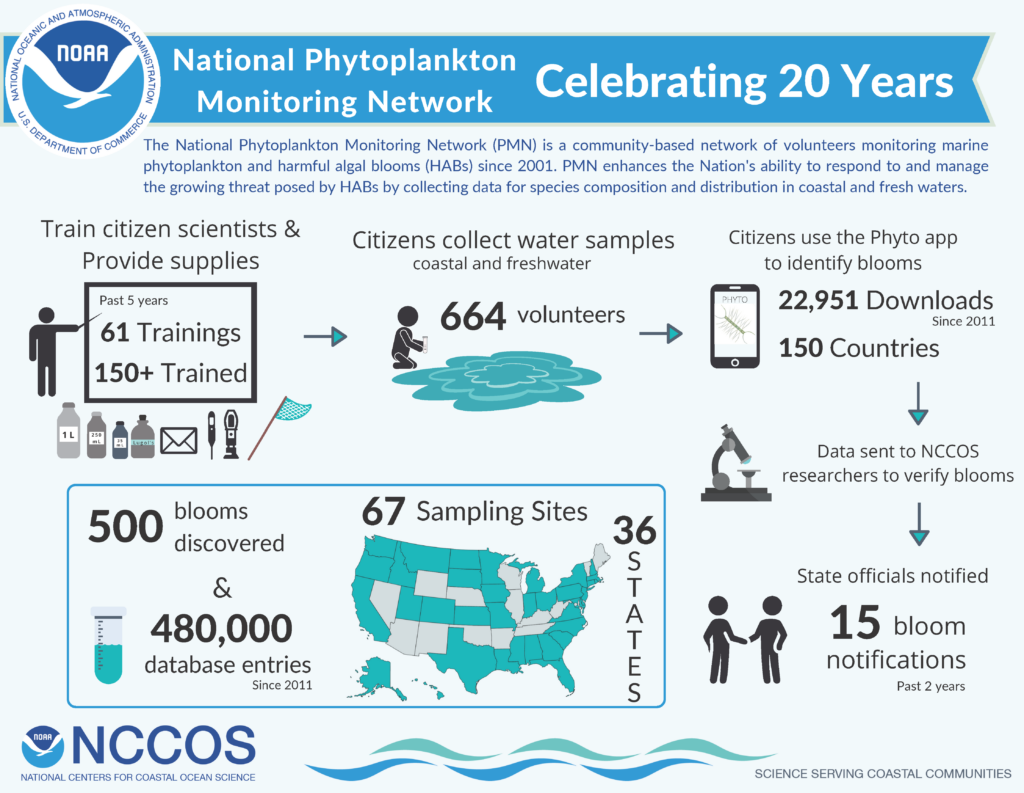
The National Phytoplankton Monitoring Network (PMN) is celebrating 20 years of improving harmful algal bloom (HAB) research through its citizen science monitoring efforts. The program has supported a national community-based network of volunteers monitoring marine and freshwater phytoplankton and HABs since 2001.
PMN recognizes the connection between humans and coastal ecosystems, and provides volunteer citizen scientists with meaningful opportunities for hands-on science engagement. Over the years, the program has enhanced the nation’s ability to respond to and manage the growing threat posed by HABs by collecting important data for species composition and distribution and creating working relationships between volunteers and professional researchers. PMN has also supported Alaska Natives in building a monitoring network for algal toxins in their subsistence, traditional, and recreational shellfish harvests. Since its inception, PMN has grown to include more than 600 volunteers across 36 U.S. states and territories.
NCCOS uses workshops and online webinars to train volunteer groups on how to collect samples, identify different species of phytoplankton using digital microscopy, and report their data to the HAB Monitoring and Reference Branch using an online database. Volunteers are supplied with necessary equipment for collection, and analyze algae samples on a weekly or biweekly basis. Once collected, the samples are preserved and sent to the NCCOS laboratory for confirmation and potential toxin determination. NOAA uses this information to support HAB forecasts and assist state and tribal managers in mitigating the effects of HABs.
PMN scientists and volunteers have helped the program achieve many noteworthy accomplishments, including:
- 2005: PMN identified the first recorded bloom of a toxic Pseudo-nitzschia species in North Carolina waters. This first time identification in the region alerted NC coastal managers to the potential for human amnesic shellfish poisoning and domoic acid toxicity to marine animals.
- 2009: PMN volunteer efforts during the coho salmon (Oncorhynchus kisutch) mortality event in Kachemak Bay, Alaska led the Alaska Department of Fish and Game to change its smolt release procedure to include phytoplankton observations.
- 2010: PMN and partners successfully launched a pilot monitoring program in Minnesota and Wisconsin to expand sampling efforts to include HABs in freshwater lakes. In 2016, PMN expanded into Lake Michigan, Huron, Superior and Erie, and a series of training workshops were held to train volunteers in collection and identification techniques for freshwater HABs.
- 2011: The first version of the smartphone application Phyto was released. The app includes images of common phytoplankton, recordings of a staff scientist’s pronunciation of each species’ name and a flash card game to improve volunteers’ identification skills. The app has since been downloaded more than 22,900 times by users in 150 countries.
- 2013 - Ongoing: By transferring sampling techniques and toxin analysis methods developed by NCCOS and providing annual training, PMN has facilitated the establishment of several Tribal HAB monitoring networks and toxin testing laboratories across Alaska, supporting 43 tribal governments.
In its 20th year, PMN is expanding its efforts to include monitoring at aquaculture sites and U.S. coastal National Parks.
The Aquaculture PMN (AQPMN) is a new program that will focus on species of phytoplankton known to reduce growth or kill shellfish and finfish aquaculture species, and will help provide aquaculture farmers and fish hatcheries with a minimum of two weeks advance warning of danger levels of harmful phytoplankton. These early warnings will help mitigate the threat of HABs, and minimize economic losses to the aquaculture industry. AQPMN is partnering with Nature Conservancy’s Shellfish Growers Climate Coalition on this initiative, which will allow for rapid expansion of the program into aquaculture farms already engaged in environmental and water quality issues. This new initiative was also introduced at the 113th annual meeting of the National Shellfisheries Association, where AQPMN presented on the dangers of HABs to aquaculture and the methods to monitor these species.
PMN will also initiate pilot projects in select coastal U.S. National Parks where park staff and volunteer groups will be trained to monitor marine HABs. As part of this project, the PMN will facilitate the collection of important data for species composition and distribution in park coastal waters, and help foster working relationships between park staff, park volunteers and NCCOS scientists. National Parks in this project include Canaveral National Seashore, Padre Island National Seashore, Acadia National Park, and Sitka Totem Park. The information collected will contribute to a larger collaborative effort with the U.S. Geological Survey, National Park Service’s Office of Public Health, and the U.S. Environmental Protection Agency Cyanobacteria Monitoring Collaborative, which provides guidance to parks nationwide on low-cost HAB monitoring tools, and options for rapid response protocols.
Thank you to all of our volunteers for their efforts, willingness, and participation. The success of the program would not be possible without you! If you’ve been part of our PMN journey, we encourage you to share your memories and experiences by using the hashtag #20YearsofPMN on social media. If you’d like to learn more about volunteer opportunities, click here.
NOAA directly supports its mission of stewardship by engaging members of the public in citizen science projects to collaboratively address real-world problems. These activities encourage people to take an active role in managing and protecting their local resources and ecosystems.
 Official websites use .gov
A .gov website belongs to an official government organization in the United States.
Official websites use .gov
A .gov website belongs to an official government organization in the United States. Secure .gov websites use HTTPS
A lock or https:// means you’ve safely connected to the .gov website. Share sensitive information only on official, secure websites.
Secure .gov websites use HTTPS
A lock or https:// means you’ve safely connected to the .gov website. Share sensitive information only on official, secure websites.